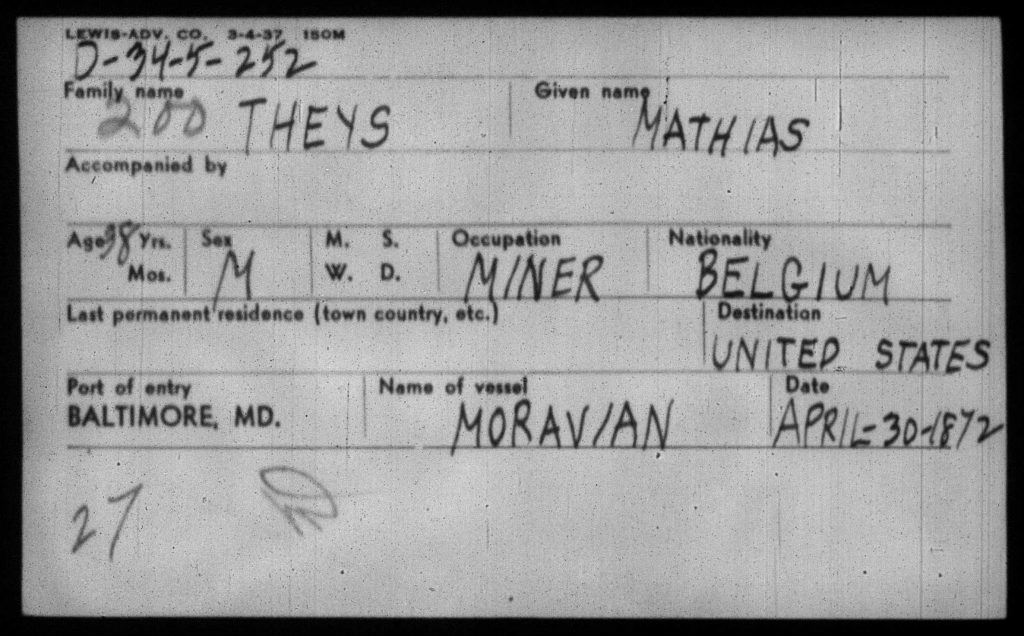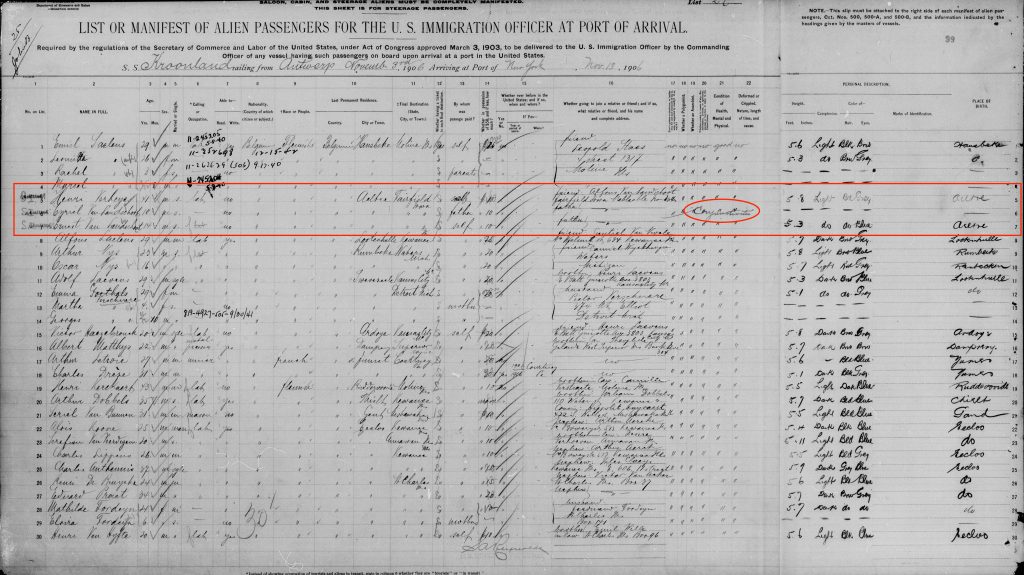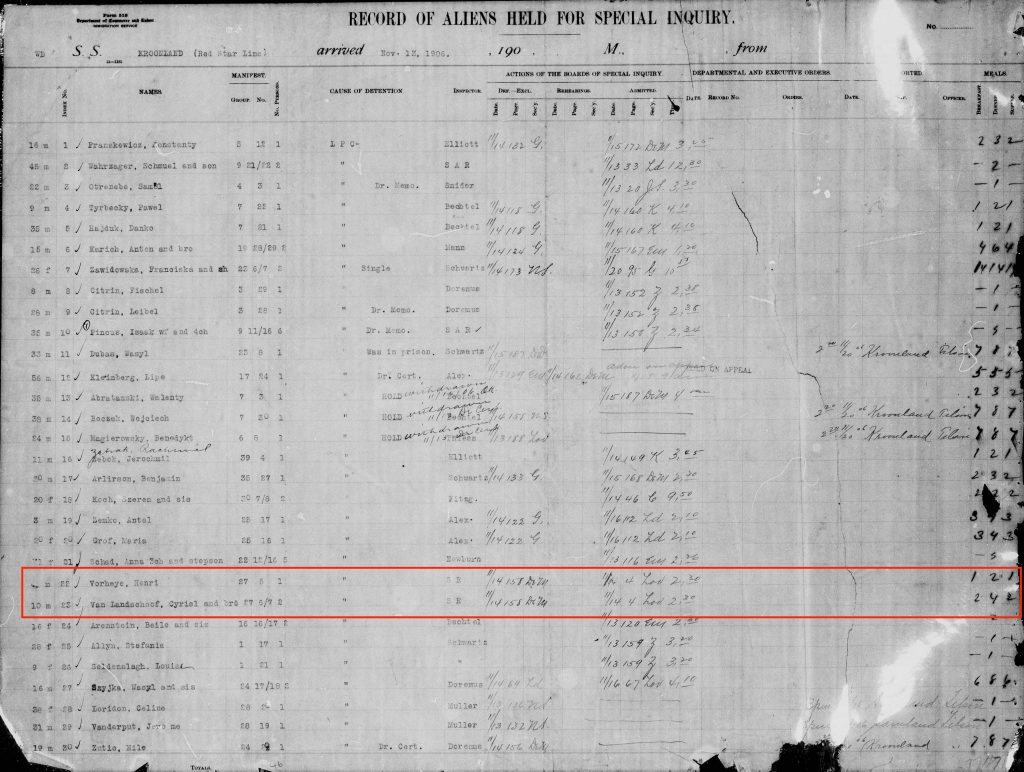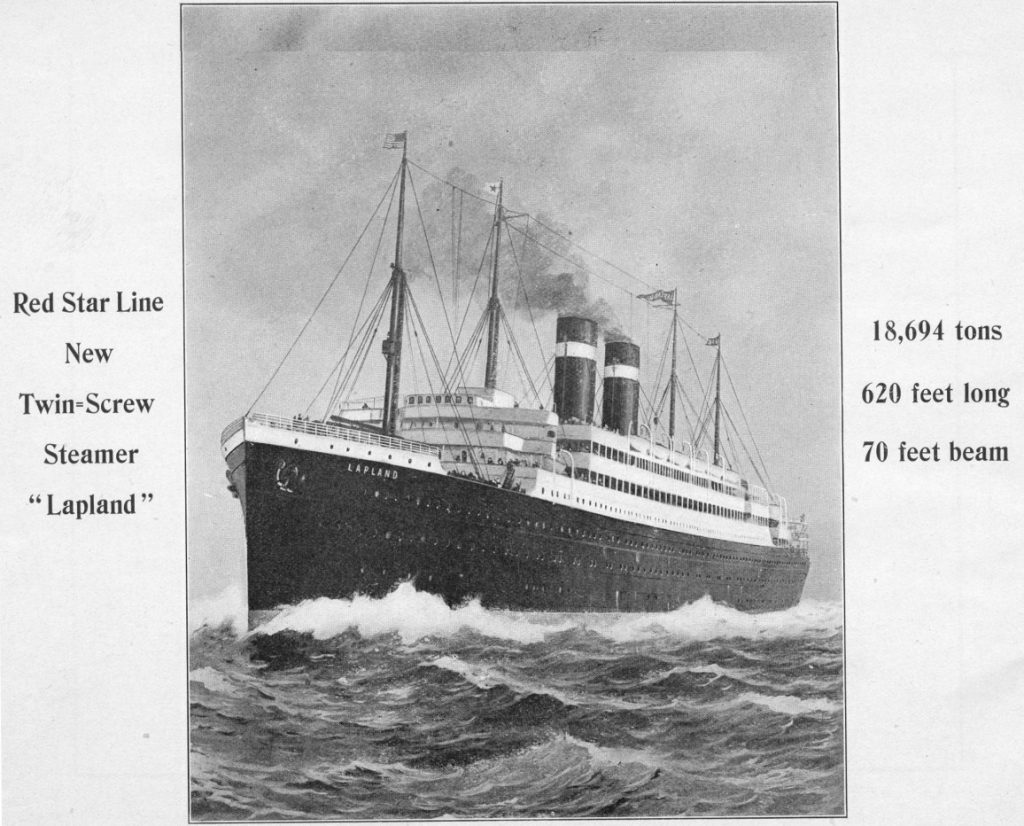Surviving ship manifests, also known as passenger lists, make it possible for most genealogists to discover details of their ancestor’s voyage to America. In an earlier post I sketched a brief history of ship manifests in the United States. In this article I share some tips for searching online databases to find Belgian-Americans in the ships’ passenger lists.
Table of Contents
Prepare
Before you delve into indexes to passenger arrival records on Ancestry, MyHeritage, or FamilySearch, narrow down your ancestor’s year of arrival as much as possible by searching other records for clues.
- Check your family archives: Look for certificates, travel documents, and letters in your family archive that can help you determine when your ancestor might have arrived in the United States.
- Search the census: Locate the ancestor in the United States census records. In 1900, 1910, 1920, and 1930, immigrants were asked what year they arrived in the US, in addition to their naturalization status.1
- Find naturalization records: Naturalization records should include the year of the applicant’s arrival in the United States.
- Read newspapers: Find obituaries which may give you a year of arrival.
- Explore city directories: The immigrant’s sudden appearance in a city or small town directory can also be a clue that he arrived in the U.S. a year or two before.
Search Like an Expert
- Allow for spelling mistakes. In fact, assume your ancestor’s name has been misspelled or mis-transcribed in the index. Try spelling variants and use wildcards. Most databases accept an asterisk (*) for multiple characters or a question mark (?) for a single character. Use wildcards to replace letters at the end, middle, and beginning of names.
- Search for women by both their maiden and married names
- Consider that your ancestor may have Americanized his or her name
- To be thorough, always search a year or two on either side of the supposed year of arrival
- Search with more and less information. Add and remove different facts in the search form.
- Until 1906, when “place of birth” was added as a question on the passenger list, it is not always helpful to limit your search by “born in Belgium.”
- Flemish passengers may have been listed as Dutch or German. Walloons may have been recorded as French.
- Search without a first or last name, if you can limit your search by adding an approximate date of birth or year of arrival.
Search at more than one website
The indexes and search engines at different online genealogy services are not identical. Different sites will allow you to search by different parameters. Different websites will often return dissimilar results. Belgian first and last names are often transcribed differently at Ancestry versus FamilySearch, MyHeritage, or FindMyPast.
For example, Philip Lettelier, who arrived at New York with his family aboard the SS Queen on 23 December 1868, is indexed as “Phillip Leselier” on FamilySearch and MyHeritage, but as “Phillip Selier” on Ancestry.2
Search specific databases
Take the time to find specific passenger list databases in the website’s catalog, as opposed to using the global search form that searches all collections, or select the “immigration records” category before you enter your query. There will be fewer results to sift through. The search form will also be more tailored to the database it is searching so that you can add more specific criteria.
- Ancestry ($) https://www.ancestry.com/search/categories/img_passlists/.
- FamilySearch: https://www.familysearch.org/en/. See list of databases in Appendix below.
- FindMyPast ($): https://search.findmypast.com/search-world-records-in-immigration-and-travel/and_passenger-lists.
- MyHeritage ($): https://www.myheritage.com/research/category-4010/passenger-lists?s=245868791.
- Statue of Liberty – Ellis Island Foundation: https://www.libertyellisfoundation.org/passenger [keep in mind that this database includes records that pre-date the opening of Ellis Island in 1892. Just because your ancestor is included in this database does not mean he arrived at Ellis Island!)]
Search the card indexes to the names in passengers lists, created by the Immigration and Naturalization Service or the Work Projects Administration. For a list, see Appendix below.

Consider other ports of arrival
Not everyone arrived at Ellis Island. Not everyone traveled via New York. New York did not become the most favored port of arrival for Belgians until after 1880. If your ancestor arrived before 1880, also search passenger lists for Baltimore, Boston, New Orleans, and Philadelphia.
Use Steven Morse’s One Step Webpages
Steven Morse’s site provides an interface to search databases with one step instead of the multiple steps required at the database’s home site. His search forms offer extra options, such as port of departure, ship name, and name of companion.
- One Step Web Pages by Steven Morse (New York): https://stevemorse.org/#ellis.
- One Step Web Pages by Steven Morse (Other ports): https://stevemorse.org/#other
Consider Canada
It was not uncommon for Belgians to arrive in the United States via Canada, especially once stricter immigration restrictions went into effect at the end of the nineteenth century. It is estimated that close to forty percent of all passengers arriving in Canada during the 1890s were bound for the United States.4 A full discussion of Canadian passenger lists and border crossing records will form part of a later post, but for now be sure to bookmark the following databases:
- “Canada Passenger Lists, 1881-1922.” Database. FamilySearch. https://www.familysearch.org/search/collection/1823240
- “United States Border Crossings from Canada to United States, 1895-1956.” Database. FamilySearch. https://www.familysearch.org/search/collection/1803785
- U.S., Border Crossings from Canada to U.S., 1895-1960. Database. Ancestry. https://www.ancestry.com/search/collections/1075/
- Border Crossings: From U.S. to Canada, 1908-1935.” Database. Ancestry. https://www.ancestry.com/search/collections/1344/.
Get the whole story
Once you have found the ship manifest for your immigrant ancestor, make sure you get the whole story.
Check every page.
Examine the entire page on which your ancestor is listed. Also check the pages before and after. Look for other Belgian passengers. Did they come from the same town? Were they going to the same place? Was the person traveling alone or in a group? If you have trouble locating your ancestor in the census or city directories, perhaps you can find one of his travel companions.
After 1906, the passenger lists are spread out over two pages, so be sure to page forwards or backwards to see the succeeding or preceding page of the manifest.
Pay attention to the margins.
Immigration officials sometimes marked the entries, either at the time of arrival, or later when they were verifying an immigrant’s arrival for other purposes.
When Cyriel and Ernest Van Landschoot, the teenage sons of Alfons Van Landschoot in Fairfield, Iowa, arrived in New York about the SS Kroonland on 12 November 1906, they were detained for two days because they showed symptoms of conjunctivitis (pink eye).5

Their entries on the passenger lists are marked “S.I.,” indicating that they were held for special inquiry. Both boys are recorded on the “Record of Aliens Held for Special Inquiry,” a list that can be found at the end of the manifest for the SS Kroonland.6

You can learn more about passenger list annotations in an article by Marian Smith, the former Immigration and Naturalization Service historian.7
Check newspapers
Look for the arrival of the vessel in newspapers of the port of arrival. Search by date and keywords such as the name of ship, or browse for “ Marine Journal,” or “Marine Intelligence” articles.
For example, an article in the Baltimore Sun informs us that when Cecile Leunis and her two small children arrived in New York aboard the SS Friesland in August 1892, the ship was quarantined briefly at the health station on Staten Island because of an outbreak of cholera in Antwerp, her port of departure.8
Similarly, the New York Times of 1 November 1861 reported that the SS Arago, which departed from Le Havre and Southampton on 16 October, experienced a “succession of strong gales and a rough passage.” One 26 October, two icebergs were spotted, and on October 28, three days prior to arrival, a certain Mrs. Henry A. Stone had died on board of “dropsy of the heart.”9
Find a description and a picture of the ship.
How big was the ship? How many passengers were on board? Find a picture and a description of the vessel that your ancestor traveled on. A few places to start your search:
- Ancestry. New York Port, Ship Images, 1851-1891. https://www.ancestry.com/search/collections/8644/
- Glenvick-Gjønvik Archives. https://www.gjenvick.com/
- Great Ocean Liners. http://thegreatoceanliners.com/
- Great Ships. https://greatships.net/
- Norway-Heritage. http://www.norwayheritage.com/query_s.asp
- Red Star Line. http://www.redstarline.eu/ships.html
- Shipslist. http://www.theshipslist.com/pictures/index.htm
- Stephen Morse’s One Step Webpages: https://stevemorse.org/ellis/pictures.html
- Wikipedia. https://en.wikipedia.org
- Wikimedia Commons. https://commons.wikimedia.org

Final Note
Be prepared to find multiple manifests that include your ancestor. Belgian immigrants were known to occasionally travel back to the homeland, especially when transatlantic travel became more affordable and less arduous during the last quarter of the nineteenth century. Some returned to Belgium for good, while many others went home to visit, or to marry, or to bring back the rest of the family. Post-1895 arrivals of these “birds of passage” may tell you the date and port of his or her previous arrival(s).
Appendix. Passenger Lists Databases on FamilySearch
Baltimore
Ship manifests
“Maryland, Baltimore Passenger Lists, 1820-1948.” Database with digital images. FamilySearch. https://www.familysearch.org/search/collection/2018318 : 2 August 2020. Citing NARA microfilm publications M255, M596, and T844.
This database includes images of passenger lists that were submitted to either the collector of customs (before 1892) or the immigration officer (after 1891) at the port of Baltimore. Be aware that the index to this database is not complete! But if you know the date of arrival — for example because you found your immigrant in one of the indexes mentioned below — you can browse the collection and find the passenger list for the specific vessel and date of arrival.
“Maryland, Baltimore, Passenger and Crew Lists of Vessels and Airplanes, 1954-1957.” Database with digital images. https://www.familysearch.org/search/collection/2072742 : 27 March 2020. Citing NARA microfilm publication M1477.
Includes lists submitted to the Immigration and Naturalization Service. Different forms were used at different times. Some records were filmed out of order.
Card indexes
“Maryland, Baltimore Passenger Lists Index, 1820-1897.” Database with digital images. FamilySearch. https://www.familysearch.org/search/collection/2173933 : 2 August 2020. Citing NARA microfilm publication M327.
Card index (Soundex system) to the names in Baltimore passenger lists for 1820-1897.
“Maryland, Baltimore Passenger Lists Index, 1897-1952.” Database with digital images. FamilySearch. https://www.familysearch.org/search/collection/3398454 : 3 August 2020. Citing NARA microfilm publication T520.
Card index to the names in Baltimore passenger lists for 1897-1952.
Boston
Ship manifests
“Massachusetts, Boston Passenger Lists, 1820-1891.” Database with digital images. FamilySearch https://www.familysearch.org/search/collection/1860873 : 2 August 2020. Citing NARA microfilm publication M277.
Passenger lists submitted to the collector of customs at the port of Boston between 2 September 1820 and March 1874 (copies from the Immigration and Naturalization Service), and between 1883 and 29 July 1891 (originals from the Boston customhouse.
“Massachusetts, Boston Passenger Lists, 1891-1943.” Database with digital images. FamilySearch. https://www.familysearch.org/search/collection/1923995 : 30 July 2020. Citing NARA microfilm publication T843.
Passenger lists submitted to the Immigration and Naturalization Service between 1891 and 1957.
Card indexes
“Massachusetts, Index to Boston Passenger Lists, 1848-1891.” Database with digital images. FamilySearch. https://www.familysearch.org/search/collection/2304666 : 23 July 2020. Citing NARA microfilm publication M265.
Alphabetical card index to the names in passenger lists of vessels arriving at the port of Boston between 1848 and 1891.
“Massachusetts, Boston Passenger Lists Index, 1899-1940.” Database with digital images. FamilySearch. https://www.familysearch.org/search/collection/2173946 : 30 July 2020. Citing NARA microfilm publications T790, T617, and T521.
Three alphabetical card indexes to the names in passenger lists of vessels arriving at the port of Boston between 1899 and 1940.
“Massachusetts, Index to Passenger Lists of Vessels Arriving at Boston, 1921-1949.” Database with digital images. FamilySearch. https://www.familysearch.org/search/collection/2526178 : 10 July 2020. Citing NARA microfilm publication A3453. Washington, D.C.: National Archives and Records Administration, 2007.
Card index to the names in passenger lists of vessels arriving at Boston, Massachusetts, 1921-1949.
New Orleans
Ship manifests
“Louisiana, New Orleans Passenger Lists, 1820-1945.” Database with digital images. FamilySearch. https://www.familysearch.org/search/collection/1916009 : 2 August 2020. Citing NARA microfilm publications M259 and T905.
Passenger lists submitted to either the collector of customs (before 1903) or the immigration officer (after 1902) at the port of New Orleans.
Card indexes
“Louisiana, New Orleans Index to Passenger Lists, 1853-1952.” Database with digital images. FamilySearch. https://www.familysearch.org/search/collection/2443949 : 1 August 2020. Citing NARA microfilm publication T527.
Card index to the names in passenger lists of vessels arriving at New Orleans, Louisiana for the years 1853-1899.
New York
Ship manifests
“New York Passenger Arrival Lists (Ellis Island), 1892-1924.” Database with digital images. FamilySearch. https://www.familysearch.org/search/collection/1368704 : 2 August 2020. Citing NARA microfilm publication T715 and M237.
Passenger lists for vessels that arrived at the port of New York between 1892 and 16 June 1897 (customs lists) and between 14 June 1897 and 1924 (immigration lists).
“New York Passenger Lists, 1820-1891.” Database with digital images. FamilySearch. https://www.familysearch.org/search/collection/1849782 : 2 August 2020. Citing NARA microfilm publication M237.
Passenger lists for vessels that arrived at the port of New York between 1820 and 1891 (customs lists). Most of the documents reproduced are original passenger lists submitted by masters of vessels to the Collector of Customs at New York; several of them for the pe-riod 1820-74, however, are copies that were inserted as substitutes for missing or illegible original documents.
“New York, New York Passenger and Crew Lists, 1909, 1925-1957.” Database with digital images. FamilySearch. https://www.familysearch.org/search/collection/1923888 : 2 August 2020. Citing NARA microfilm publication T715.
Passenger lists for vessels that arrived at the port of New York in 1909, between 1925 and 1957.
Card indexes
“New York Book Indexes to Passenger Lists, 1906-1942.” Database with digital images. FamilySearch. https://www.familysearch.org/search/collection/2299396 : 31 July 2020. Citing NARA microfilm publication T612.
These alphabetical indexes to the names in passenger manifests are grouped by shipping line and arranged chronologically by date of arrival in the Port of New York. When you find someone in this database, look at the associated image and then scroll back through the images until you get to the page that lists the name of the vessel and the arrival date in New York
“New York, New York, Index to Passenger Lists, 1820-1846.” Database with digital images. FamilySearch. https://www.familysearch.org/search/collection/1919703 : 16 June 2020. Citing NARA microfilm publication M261.
Alphabetical card index to the names in passenger lists of vessels arriving at the port of New York during the years 1820-46 and some later years.
“New York, New York, Index to Passengers Lists of Vessels, 1897-1902“, Database with digital images. FamilySearch. https://www.familysearch.org/search/collection/3031525 : 30 July 2020. Citing NARA microfilm publication T519.
Card file index to the names in passenger lists of vessels that arrived in New York between June 16, 1897 and June 30, 1902.
“New York, New York, Soundex to Passenger and Crew Lists, 1887-1921.” Database with digital images. FamilySearch. https://www.familysearch.org/search/collection/2443349 : 14 June 2016. Citing NARA microfilm publication A3485.
Soundex card index to the names in passenger and crew lists for the years 1887 to 1921.
Philadelphia
Ship manifests
“Pennsylvania, Philadelphia Passenger Lists, 1800-1882.” Database with digital images. FamilySearch. https://www.familysearch.org/search/collection/1908535 : 2 August 2020. Citing NARA microfilm publication M425.
Passenger lists of vessels arriving at the port of Philadelphia from foreign ports, l800-82. The documents for the years 1800-1819 are inward cargo manifests that include names of passengers. Most of the documents for the period 1820-1882 are original passenger lists submitted by masters of vessels to the collector of customs at Philadelphia; several lists for the period 1820-1854 are copies that were inserted as substitutes for missing or illegible original documents.
“Pennsylvania, Philadelphia Passenger Lists, 1883-1945.” Database with digital images. FamilySearch. https://www.familysearch.org/search/collection/1921481 : 2 August 2020. Citing NARA microfilm publication T840.
Passenger lists of vessels arriving at the port of Philadelphia from foreign ports, 1883-1945.
Card indexes
“Pennsylvania, Philadelphia Passenger Lists Index, 1800-1906.” Database with digital images. FamilySearch. https://www.familysearch.org/search/collection/2173965 : 2 August 2020. Citing NARA microfilm publication M360.
Card file index to the names in passenger lists of vessels that arrived in Philadelphia between 1800 and 1906.
Bibliography
Colletta, John P. They Came in Ships: A Guide to Finding Your Immigrant Ancestor’s Arrival Record. Rev. 3rd ed. Orem, Utah: Ancestry Publishing, 2002.
Immigrant & Passenger Arrivals: A Select Catalog of National Archives Microfilm Publications. 2nd ed.. Washington, DC: National Archives Trust Fund Board, 1991.
“Ship Passenger Lists and Immigration Records: A Genealogy Research Guide.” Genealogy Research guides, Tips and Online Records – USA. http://researchguides.net/immigration/index.htm : 2020.
Tepper, Michael. American Passenger Arrival Records. Updated and enlarged ed. Baltimore: Genealogical Pub. Co., Inc., 1999. WorldCat.
U.S. National Archives & Records Administration. “Immigration Records.” National Archives (webpage). Updated 6 April 2020. https://www.archives.gov/research/immigration/overview.
Cite this post: Kristine Smets, “Finding Belgian Americans in United States’ Passenger Lists. Part II: Research Tips” The Belgian American, (https://thebelgianamerican.com : accessed [date]), posted 4 August 2020.
- Census enumerators for the 1890 census also recorded the number of years immigrants had been in the United States, and the naturalization status, but most of this census was unfortunately destroyed in a 1921 fire in the Commerce Department Building.
- “New York Passenger Lists, 1820-1891,” database with images, FamilySearch (https://familysearch.org/ark:/61903/1:1:QVPV-Q2ZV : accessed 1 July 2020), manifest SS The Queen, from Liverpool, England, and Queenstown, Ireland, to New York, arriving 23 December 1868. Also, “New York, Passenger and Crew Lists (including Castle Garden and Ellis Island), 1820-1957,” database with images, Ancestry (https://search.ancestry.com/collections/7488 : accessed 23 June 2020), entry for Phillip Selier. Both citing Immigration, New York City, New York, United States, NARA microfilm publication M237, roll 305.
- Maryland, Baltimore Passenger Lists Index, 1820-1897, database with images, FamilySearch (https://familysearch.org/ark:/61903/1:1:QV9F-TV9B : 16 March 2018), Mathias Theys, 1872; citing NARA microfilm publication M327.
- Michael Tepper, American Passenger Arrival Records, upd. and enl. ed. (Baltimore, Maryland: Genealogical Pub. Co., 1993), p. 121.
- “New York Passenger Arrival Lists (Ellis Island), 1892-1924,” database with images, FamilySearch (https://familysearch.org/ark:/61903/3:1:3Q9M-C959-HGST?cc=1368704&wc=4FS7-W4S%3A1600342325 : 26 January 2018), Roll 796, vol 1801-1802, 12 Nov 1906 > image 200 of 562, manifest SS Kroonland, Antwerp, Belgium, to New York City, arriving 12 November 1906, list 27, lines 6-7, Cyriel and Ernest Van Landschoot; citing NARA microfilm publication T715, roll 796.
- “New York Passenger Arrival Lists (Ellis Island), 1892-1924,” database with images, FamilySearch (https://familysearch.org/ark:/61903/3:1:3Q9M-C959-HLCS?cc=1368704&wc=4FS7-W4S%3A1600342325 : 26 January 2018), Roll 796, vol 1801-1802, 12 Nov 1906 > image 260 of 562, manifest SS Kroonland, Antwerp, Belgium, to New York City, arriving 12 November 1906, record of aliens held for special inquiry, line 23, Cyriel and bro. Van Landschoof; citing NARA microfilm publication T715, roll 796.
- Marian L. Smith, “Manifest Markings: A Guide to Interpreting Passenger List Annotations,” JewishGen: The Global Home for Jewish Genealogy (https://www.jewishgen.org/infofiles/manifests/), last revised 29 September 2002.
- “At New York Quarantine: The Steamship Friesland Ordered to Remain for Five Days,” Sun (Baltimore, Maryland), 31 August 1892, p. 2, col. 2-3. Also, “Busy Times at Quarantine,” New York Times, 31 August 1892, p. 5, col. 3-4. For Cecile’s arrival record, see “New York Passenger Arrival Lists (Ellis Island), 1892-1924,” database with images, FamilySearch (https://familysearch.org/ark:/61903/3:1:33SQ-G1DW-WL4?cc=1368704&wc=4FMB-7ZJ%3A1600262328 : accessed 13 July 2020), Roll 596, 23 Aug 1892-7 Sep 1892 > image 413 of 668, manifest SS Friesland, Antwerp, Belgium, to New York, arriving 31 August 1892, 403, Cecile Leunis; citing NARA microfilm publication M237, roll 596; Ancestry indexes as Ceale Leunis.
- “Marine Intelligence,” New York Times, 1 November 1861, p. 8, col. 6.
- Red Star Line Brochure, Wikimedia Commons, https://commons.wikimedia.org/wiki/File:Red_Star_Line_brochure_1.jpg.


Wonderful article, Kristine! Thank you very much.